Exploring the Abra Boat Service in Dubai
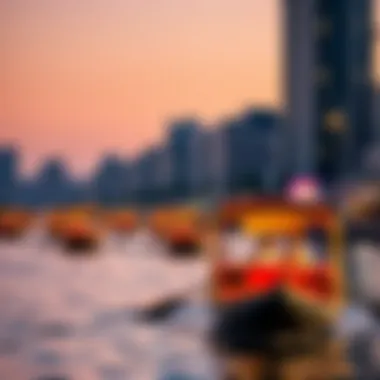
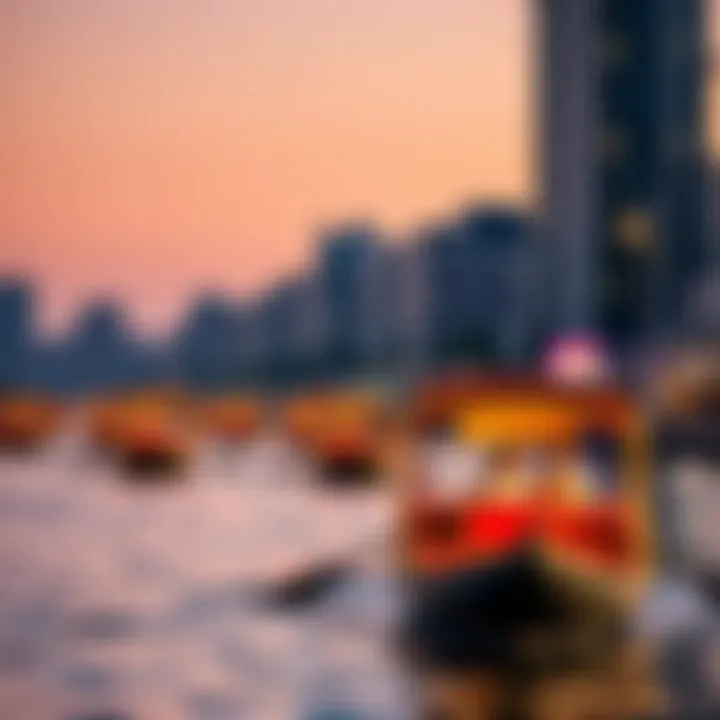
Intro
Dubai's abra boat service has long been an essential thread woven into the fabric of the city’s rich cultural tapestry. As a picturesque, traditional mode of transportation traversing the city's waterways, abras not only offer a sense of nostalgia but also a pragmatic solution to modern urban connectivity. This article aims to provide a comprehensive guide that explores various facets of the abra service, underscoring its significance in the broader context of Dubai’s ever-evolving urban landscape.
The abra service is particularly notable for its ability to connect diverse neighborhoods, promoting both daily commutes and leisurely excursions across the city's creeks. From the bright, bustling streets of Deira to the vibrant district of Bur Dubai, the abra acts as both a vehicle and a facilitator, navigating the passage of heritage and innovation alike. Such a service enhances the journey of locals and tourists while quietly boosting the surrounding real estate landscape and fostering community engagement.
In the following sections, we will delve into how the abra service operates, its various types, and its architectural charm. We will also explore its role in enhancing property values in neighboring areas and discuss emerging trends in real estate linked closely to these water transport systems. By the end of this guide, readers will gain a holistic understanding of how this traditional means of transportation has adapted and thrived within the modern framework of Dubai, unearthing layers of complexity and connection that extend beyond mere transit.
Overview of Abra Boat Service
The abra boat service is a lifeline for transport across Dubai’s majestic waterways. It links various areas, from bustling markets to luxury hotels. This service is not merely about getting from point A to point B; it’s imbued with cultural significance and a unique charm that embodies the spirit of Dubai itself. Investors, real estate agents, and analysts should particularly appreciate the interconnectedness it fosters within the urban fabric.
Historical Context
Historically, abras have roots that can be traced back centuries. Initially used by local fishermen, these wooden boats played an essential role in trade and daily commutes between districts. The simplicity of their design and construction made them widely accessible. During the late 19th century, as the city began to flourish, abra services expanded, connecting burgeoning communities around Dubai Creek.
Today, this service symbolizes the city’s transformation from a small fishing village into a thriving metropolis, encapsulating Dubai's rich maritime and trading heritage.
Modern Evolution
In recent years, the abra service has undergone significant modernization while retaining its traditional essence. Today, there are motorized versions that include features to enhance passenger comfort and efficiency. While the classic wooden abras still navigate the waters, modern abras offer a faster and smoother ride, catering to both locals and tourists alike.
Investments in the service have increased, reflecting the city’s commitment to maintaining cultural authenticity while embracing progress.
The integration of technology also plays a vital role in this evolution; apps that display real-time arrivals and routes have become invaluable for users seeking convenience. The abra boat service stands today not only as a mode of transport but also as a point of interest itself, providing picturesque views of Dubai’s skyline and rich architecture.
Types of Abras
Understanding the various types of abras is key to appreciating their role in Dubai's waterway transport system. Each type serves distinct purposes and caters to different user needs, reflecting both tradition and modernity. Knowing these types not only aids potential users in choosing the right service but also provides insights into their relevance in the broader context of urban connectivity and cultural heritage.
Traditional Abras
Traditional abras hold a significant place in Dubai's history, symbolizing the city's maritime roots. These wooden boats, often handcrafted, date back decades, serving as a primary mode of transportation before roads and bridges became prevalent. The atmosphere on a traditional abra is unique; the smell of the wood, the sounds of water lapping against the hull, and the gentle sway create an experience steeped in nostalgia.
While their structure may be basic, the charm lies in their simplicity. These abras are powered by a single engine, which offers sufficient maneuverability for short routes across the Dubai Creek. The journey on one of these vessels is often a quiet respite from the bustling life on the shore, allowing riders to absorb the sights and sounds of the waterway.
Benefits of Traditional Abras:
- Cultural Authenticity: Riding a traditional abra connects users to Dubai's heritage.
- Cost-Effective: Fares are typically lower, making this option accessible for everyone.
- Scenic Views: Provides an unparalleled perspective of the city's skyline, especially at sunset.
Modern Motorized Abras
In contrast to their traditional counterparts, modern motorized abras showcase Dubai's embrace of technological advancements. These boats, often constructed with contemporary materials, can accommodate larger groups and operate at higher speeds. They feature improved stability and safety measures, making them suitable for various demographics, including families and tourists.
Modern abras are integral to the Dubai Water Transport system, offering services across more extensive routes and connecting key areas around the city. With navigation systems in place, these vessels provide a more reliable experience, often incorporating real-time tracking technologies. Passengers can enjoy a smoother ride, complete with amenities like comfortable seating and shaded areas.
Considerations for Users:
- Larger Capacity: Ideal for group outings and events.
- Safety Features: Equipped with modern safety gear, including life vests and communication systems.
- Environmental Efficiency: Many motorized abras are designed to be more fuel-efficient, addressing sustainability concerns.
Overall, both traditional and modern abras present unique experiences that cater to various user preferences while underlining their importance in Dubai’s urban ecosystem. Understanding these differences enhances the appreciation of the abra services and their role in maintaining a continuous link between the past and the present.
"The abra isn't just a means of transport; it's a passage through time, weaving the stories of Dubai's rich cultural tapestry."
For further insights, consider exploring this Wikipedia page on Abras, which delves deeper into their significance and evolution.
Operational Framework
The operational framework of the abra boat service serves as the backbone of its functionality in Dubai's bustling maritime ecosystem. Understanding this framework is key for investors, agents, and anyone interested in the intricate dance of transportation and urban development in this vibrant city. The operational elements include service routes, fare structures, and how these impact user experience and economic growth.
Service Routes
The service routes of the abra boats are not just a means of transportation; they weave through the very fabric of Dubai's urban landscape. Covering critical points from one bank of the Dubai Creek to another, these routes connect hubs of activity such as the Dubai Spice Souk, the Gold Souk, and several residential districts. The flow of these routes not only facilitates daily commutes for locals but also attracts tourists seeking an authentic experience.
Some key characteristics of these service routes include:
- Direct Access: Abras can transport passengers quickly between key areas, a boon for the busy urbanite. While road traffic often slows down other forms of transportation, the abra's waterway routes remain relatively unencumbered.
- Scenic Views: Commuters get to enjoy breathtaking views of the skyline and traditional architecture along the banks of the creek—an added charm that other transport modes can't offer.
- Frequency & Reliability: The boats generally run every few minutes during operational hours, making them a reliable choice for users eager to avoid waiting long.
These aspects enhance the user experience and promote a sustainable transportation model that resonates well with both tourists and residents alike.
Fare Structure
The fare structure of the abra service is another critical aspect to consider. Simplicity is at its core—transportation should not be a puzzle. The pricing model is designed to be affordable, which encourages higher uptake among users. Typically, a short ride costs just a few dirhams, making it accessible to a wide demographic. For regular commuters, there might be options for monthly passes, thus further ensuring ease of access.
Key points regarding the fare structure include:
- Affordability: Keeping fares low ensures that even the economically constrained can access this vital service, fostering a sense of inclusion and community.
- Transparent Pricing: With fixed rates and clear information on fare structures posted at docks, users know what to expect when they arrive. This transparency builds trust and encourages ridership.
The abra is not just a boat; it is a bridge between cultures, histories, and current realities in Dubai.
Relevant Resources
Cultural Significance
The cultural significance of the abra boat service is multifaceted. It serves as a bridge between Dubai's rich history and its modern-day identity, encapsulating the essence of a city that fuses tradition with progress. While many may view the abra as merely a mode of transport, its role extends far beyond that, embodying high hopes and connecting communities across the water. Understanding this importance allows potential stakeholders, from investors to users, to appreciate the deeper layers of relevance this service has in the urban framework of Dubai.
Connection to Dubai's Heritage
The abra is rooted deeply in the heritage of Dubai. Historically, these wooden boats were the lifelines of the region, linking various parts of the burgeoning city. They trace back to a time when the waters of Dubai Creek served not just as a source of trade but as a vivid tapestry of social interaction.
Taking a ride on an abra is not just about getting from point A to point B; it’s an experience rich with echoes of the past. Consider how the old trading routes facilitated commerce between local and external markets, how residents relied on these vessels to transport goods, and how the boat builders skillfully crafted their designs, often passed down through generations. The craftsmanship and design of traditional abras reflect Dubai's maritime heritage. These boats represent an era when connectivity was limited to these waterways, evoking a strong sense of nostalgia among older residents.
Moreover, abras frequently feature local folklore and traditional music, enhancing their role as cultural vessels. A ride may lead to incidental conversations with co-passengers, sharing stories that remind them of how intertwined their lives are. The abra thus becomes a moving classroom of history, inviting all who board to reflect on the city’s transformative journey.

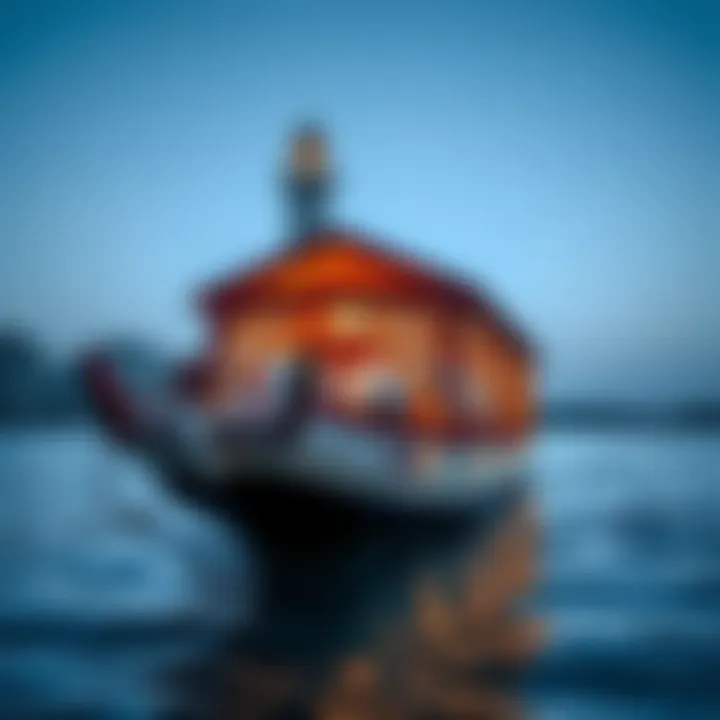
Symbol of Community Interaction
Beyond their historical context, abras are also vital in fostering community interaction. In an age where cities can feel fragmented by urban sprawl, these boats bring together diverse groups of people who may otherwise not cross paths. As passengers share the space, a micro-community is created on each journey. The chatter between local workers, tourists, and families resonates with a sense of shared experience, fostering social cohesion.
The abra docks are often alive with activity, from lively exchanges to moments of small, unexpected conversations. Residents utilize this service not only for transportation but also as a social platform that nurtures relationships and dialogues. In this light, abras serve as a means of not just commuting but also facilitating a sense of belonging among riders.
For real estate agents and investors, this vibrant community aspect could be key to understanding how property values and local development initiatives can be influenced by the ongoing relevance of abra services. When housing communities are built near these waterways, they often capitalize on the unique cultural experience of living within reach of such a prized resource.
As Dubai continues its rapid urban transformation, a connection to the abra service remains constant, demonstrating how a seemingly simple transportation method can evolve into a crucial emblem of local identity and unity.
Role in Urban Development
The abra boat service is not merely a quaint mode of transportation; it has become integral to the urban development fabric of Dubai. This service enhances connectivity between districts, providing an efficient alternative to ground traffic, particularly in a sprawling metropolis where congestion can often be a headache. The abra operates as a vital artery, facilitating movement with a charm that modern transit lacks. Without a doubt, the significance of the abra transcends its primary function of transportation, reflecting Dubai's evolving urban narrative and the careful integration of its cultural heritage into modern city planning.
Integration with Real Estate Projects
The link between the abra service and real estate development is profound. New waterfront properties often capitalize on proximity to abra routes, allowing developers to market homes and commercial spaces with direct access to this unique transport network. For example, projects near the Dubai Creek might highlight their residents' ability to whisk away on a traditional abra to various destinations in mere minutes.
Investors have started to notice the patterns emerging from this synergy. Higher demand for properties close to abra stations points to a growing appreciation for accessibility blended with cultural immersion. Besides that, the aesthetics of the area benefit as well. A well-developed waterfront with active abra operations tends to enhance the visual appeal of real estate projects.
It's essential for buyers and agents to keep an eye on how new real estate initiatives plan to incorporate or consider the abra into their design. Absence of such integration might mean missing out on maximizing the potential of the property. One might say, “Location, Location, Location” applies not just to the land but also to the forms of connectivity surrounding it.
Impact on Property Values
The impact of the abra service on property values cannot be overstated. Areas with access to this form of transport generally enjoy elevated property values relative to those without similar access. The presence of a nearby abra station is often viewed positively by potential homeowners and investors alike.
When comparing property values in locations served by abras versus those further removed, trends indicate a clear difference. For instance:
- Properties adjacent to abra stations often see a value increase of 10-20%, depending on the overall property demand and location desirability.
- Areas with robust connections to tourism through the abra service attract investors who see an opportunity for rental gains.
- The perception of convenience and cultural novelty associated with living near abra routes often leads to faster sales, as buyers seek out these vibrant hubs.
In summary, the accessibility provided by the abra boat service presents a competitive advantage in the real estate market of Dubai.
With the potential for property appreciation driven by such unique transportation options, savvy investors might want to factor in the abra's role in their strategic planning. It’s not just about bricks and mortar anymore; it’s about how those bricks connect to the heartbeat of Dubai’s dynamic urban landscape.
Sustainability Considerations
The sustainability of the abra boat service is not merely a side note; it’s central to how this iconic form of transport can flourish while maintaining ecological integrity. This section dives into the fundamental aspects of sustainability through environmental impact and strategies for future-proofing the service.
Environmental Impact
The abra service, operating across Dubai’s waterways, has a footprint that’s worth scrutinizing. Traditional abras use simple designs, primarily crafted from wood, which might seem eco-friendly at first glance. However, sourcing and maintaining these materials raises several concerns regarding deforestation and habitat disruption. The challenge lies in balancing the cultural heritage associated with wooden abras and the urgent need to minimize environmental degradation.
Key Considerations for Environmental Impact:
- Pollution Control: The diesel engines in modern motorized abras contribute to water pollution and air quality concerns. Transitioning to cleaner alternatives would greatly lessen this impact.
- Preservation of Aquatic Life: With careful route planning and operating schedules that consider breeding cycles, the abra service can minimize disruption to local marine ecosystems.
- Waste Management: Implementing effective waste management practices on board can reduce litter and pollutants entering the waterways, preserving their beauty and biodiversity.
"Sustainability isn't just a buzzword; it’s a necessity, especially as urban areas expand into delicate ecosystems."
Future-Proofing the Service
As Dubai presses forward with its ambitious development plans, future-proofing the abra service becomes paramount. This means incorporating innovative strategies that align with both urban growth and environmental stewardship.
Approaches to Future-Proofing:
- Adopting Green Technologies: Leveraging solar and electric-powered abras could provide a sustainable energy source, aligning with global shifts toward greener transportation options.
- Community Involvement: Engaging local communities in sustainability initiatives can foster a sense of ownership and responsibility, ensuring long-term success and adherence to eco-friendly practices.
- Educational Programs: Educating both operators and users on sustainability matters can raise awareness about the environmental impact of their choices and promote more conscious behavior.
The future of the abra service will hinge not only on its ability to adapt but also its commitment to sustainable practices. Such foresight can ensure that this traditional transport method remains a viable, exciting part of the Dubai landscape for generations to come. By actively addressing environmental concerns and implementing forward-thinking strategies, the abra service can continue to thrive amidst an ever-changing urban environment.
Technical Insights into Abras
Understanding the technical aspects of abras is crucial for anyone interested in this unique mode of transportation. An abra is not just a boat; it encapsulates the rich culture of Dubai, reflecting its history while embracing modern requirements. Investing in these insights can greatly enhance your appreciation for the service while also offering strategic advantages for those involved in the real estate sector. This section dives deep into their design, construction, and safety protocols, ensuring users and stakeholders are well-informed.
Design and Construction
The design of abras tends to reveal a lot about their purpose and functionality. Traditional abras, often made from wood, feature a flat bottom which allows them to navigate the shallow waters of Dubai's creek with ease. The simplicity of their design also plays into their operational efficiency. The dimensions typically range from 8 to 10 meters long, accommodating around 20 passengers at a time.
In contrast, modern motorized abras have introduced a touch of engineering advancement. These vehicles possess more robust materials, often integrating fibreglass or aluminum, which improves durability and performance. The modern variants are equipped with engines and can achieve higher speeds, allowing them to serve a greater number of commuters efficiently.
Key Features of Abras’ Construction:
- Materials Used: Traditionally wood, but modern versions may use fibreglass and aluminum.
- Capacity: Typically designed for approximately 20 passengers.
- Engine Power: In motorized settings, powerful engines enhance speed and efficiency.
The craftsmanship of abras isn’t just about aesthetics; it reflects the cultural significance, pride, and tradition of marine navigation in the region. Whether an old-fashioned wooden abra or its contemporary counterpart, their construction brings together history and modernity seamlessly.
Safety Regulations
Safety regulations for abra services are paramount, given the heavy reliance on this transport form by both locals and tourists. The local government has established safety standards that operators must adhere to, ensuring that the experiences aboard these vessels are both enjoyable and secure.
Some of the key safety measures include:
- Regular Inspections: All abras are subject to periodic checks to ensure they are seaworthy. Inspectors look for structural integrity, engine performance, and emergency equipment.
- Life Jackets and Equipment: Every vehicle must have enough life jackets for all passengers, along with other safety equipment ready to use in emergencies.
- Training for Operators: Abra operators undergo training to handle the vessel safely and respond effectively in emergencies.
"When safety becomes second nature, only then can the beauty of the journey truly shine."
Maintaining stringent safety regulations not only protects users but also fosters confidence in the service, encouraging more people to opt for this unique alternative. Using abras becomes more than just a mode of transport; it transforms into a cherished experience where safety and tradition walk hand in hand.
For further details, you can explore resources like Wikipedia on Abras or official governmental sites that provide guidelines on safety and regulations.
User Experience
In discussions about the abra boat service in Dubai, the topic of user experience is pivotal. Understanding how passengers feel while using the service helps not only in enhancing customer satisfaction but also in ensuring that the system continues to thrive in a bustling city like Dubai. User experience encompasses various elements including the comfort offered during the ride, the reliability of service timings, and the overall aesthetics of the experience. Each of these components has a significant impact on how the service is perceived by locals and tourists alike.


Customer Insights
Gaining insights from customers is crucial for improving the abra service. Generally, users express a mix of feelings about their journey. Many appreciate the views of Dubai’s iconic skyline and the sense of connection to the city’s history that the abra provides. For instance, a passenger might mention that riding an abra feels like travelling through time, linking modern skyscrapers to the heritage of the trading past.
On the flip side, there are common complaints that often surface regarding overcrowding, wait times, and safety. Some passengers note that during peak hours, getting a spot on an abra can be as tricky as finding a needle in a haystack. Their concerns often focus on the squeezing in of too many people, which can diminish the enjoyment of the ride. Users also frequently mention that the sound levels—both from the engine and from fellow passengers—can rise to an uncomfortable level. These firsthand experiences help city planners and service providers accurately gauge where they can enhance the service.
Suggestions for Improvement
Improving user experience for the abra service should focus on addressing key areas identified from customer insights. Here are a few suggestions:
- Implementing a Booking System: Given the traffic during peak times, introducing a simple digital booking system could help alleviate overcrowding. This would allow passengers to reserve a seat and expect their ride at a specified time, thus reducing the mad rush often seen at docking stations.
- Enhancing Safety Demonstrations: To make passengers feel at ease, abrabuilder could introduce quick safety briefings before each ride.
- Community Feedback Initiatives: Establishing a direct line for feedback—maybe through a dedicated app or webpage—would empower users to voice their opinions regularly. In turn, this data could be used meaningfully to shape ongoing improvements.
- Maintenance of Modern Abras: With the growing popularity of motorized abras, ensuring that these vessels are always maintained and operational will improve reliability. Regular updates and checks can prevent technical failures that lead to delayed services, which often frustrate users.
By focusing on these improvements, the abra service can enhance its reputation and further integrate it within the daily lives of both residents and visitors.
By keeping the user experience at the forefront of the operational priorities, the abra service can continue to be a cherished part of Dubai’s transport network.
Comparative Analysis
Understanding the Comparative Analysis section is pivotal for grasping how the abra service fits within the broader spectrum of transportation options in Dubai. This analysis not only uncovers the unique merits of using abras but also highlights their significance relative to other modes of transport. Abras provide a scenic and efficient alternative, catering to both locals and tourists alike. By peeling back the layers of how the abra service stands against buses, taxis, and even the metro, one can appreciate the logistics of traversing this bustling city.
Abra Service vs. Other Transportation Modes
When contrasting the abra service with other transportation options, several compelling factors come to light:
- Cost-Effectiveness: Abras offer an economical fare structure compared to taxis, making them a preferred choice for budget-conscious commuters. For instance, while a taxi ride can rack up costs quickly, an abra fare is often just a few dirhams, catering to all walks of life.
- Scenic Routes: Navigating the waterways via abra presents an unparalleled view of Dubai’s stunning skyline. Unlike buses or the metro, the experience is inherently picturesque, allowing passengers to bask in the city’s beauty from the water.
- Cultural Experience: Using an abra provides a taste of local heritage that other modes lack. Riders can engage with the traditional aspect of Dubai’s culture in a way that feels personal and authentic. This connection to history enriches the overall experience for users.
- Time Efficiency: Depending on the time of day, abras can sometimes provide a faster route than road transport, particularly in traffic congestion. They carve through the waterways, creating a swift option for crossing the Dubai Creek, saving time and stress.
In sum, while taxis and buses may provide certain conveniences, abras bridge the gap between transportation and cultural immersion, highlighting Dubai’s unique maritime heritage.
Global Comparisons
Looking at the abra service in a global context reveals some interesting insights. Many cities around the world have their own versions of water transport, yet few achieve the same level of cultural significance as the abra services in Dubai. Here are a few comparisons:
- Venice, Italy
Similar to Dubai’s abras, Venice offers vaporetto services. However, while both immerse users in waterway experiences, Venice’s service is predominantly for tourists, while abras cater to both locals and visitors alike, emphasizing daily utility alongside leisure. - Bangkok, Thailand
The chao phraya express boat is another efficient waterway system, but it lacks the rich heritage and community ties associated with Dubai's abra service. In Bangkok, the focus is more on fast transport, while abras balance efficiency with cultural identity. - Hong Kong
The Star Ferry connects various parts of the city across the harbor. While it serves a critical transport function, much of its appeal lies in tourism, contrasting with the abras as a regular choice for many residents.
These comparisons illustrate that the abra service is not merely about getting from point A to B but instead encapsulates a deeper cultural narrative, making it a distinctive point of pride for Dubai. Through this lens, one can appreciate the abra service as a model worth studying for both its utility and its charm.
"The abra service is not just a mode of transportation; it’s a journey through the heart of Dubai's culture and history, uniting the past with the present."
This comparative analysis serves as a reminder that the abra boat service is more than just a transport route; it's a vessel for culture and community interconnection, valuable in the context of urban mobility and sustainability.
Future Outlook
The future outlook for the abra boat service is not just a matter of maintaining a tradition. It encompasses a wide array of developments, challenges, and adaptations to urban change. As cities evolve, so must their transportation networks. Here in Dubai, the abra service holds a unique position not only as a nostalgic slice of history but also as a forward-looking transport solution poised to enhance urban mobility.
Technological Innovations
In recent years, the integration of technology into the abra boat service has become vital. From mobile apps that help users locate the nearest stations to electronic ticketing systems, modernization is key to engaging a tech-savvy user base. Companies like Careem, traditionally known for its car-hailing services, have ventured into similar waters, literally and figuratively, proposing partnerships to streamline access and payment solutions for travelers.
Enhancements driven by technology might include:
Automated scheduling systems that improve service frequency
- Smart sensors to check boat conditions in real-time
- Geographic Information Systems (GIS) to optimize routes based on real-time traffic data
The buzz around smart cities and seamless transport suggests that the abra service will not be stuck in the past, but rather it can leap into a high-tech future.
Predicted Developments
Looking ahead, we can anticipate several key trends influencing the abra service directly. With sustainability taking center stage in urban planning, it’s likely that electric-powered abras will emerge, replacing some of the traditional diesel models, contributing to the city’s carbon-neutral goals. Furthermore, urban density is set to increase, leading to the development of new routes that connect emerging residential and business districts with waterfront areas.
Other potential developments include:
- Community-Based Services: Engaging local communities more actively could foster a sense of ownership and improve service adaptability.
- Partnerships with Tourism Boards: Collaborations aimed at positioning abras as scenic rides for tourists could boost ridership and revenue, showcasing the beauty of Dubai's waterways.
- Accessibility Improvements: Adaptations for individuals with disabilities can enhance inclusivity, meeting modern standards thoroughly.
As we face these changes, it’s critical that stakeholders closely monitor trends and invest wisely in necessary infrastructure. In doing so, they not only fortify the role of abras as reliable transport but also enhance their standing in a modern, interconnected Dubai.
Legal and Regulatory Framework
Understanding the legal and regulatory framework surrounding the abra boat service in Dubai is crucial for anyone invested in this mode of transport. The framework not only ensures the operational integrity of the service but also aims to protect both users and operators from potential pitfalls. This section delves into the pivotal governance structures and compliance requirements that form the backbone of the abra service, highlighting their significance for stakeholders and the community at large.
Governance Structures
The governance structures governing the abra boat service are designed to maintain order, safety, and efficiency. The Dubai Maritime City Authority (DMCA) is primarily responsible for establishing rules and regulations pertinent to the operation of abras. This body oversees licensing, route designation, and safety protocols, ensuring that the service aligns with global best practices.
- Key Responsibilities of DMCA:
- Development of maritime policies that encompass safety and operational standards for abras.
- Coordination with other governmental entities to ensure seamless transportation across waterways.
- Regular assessment of service quality and compliance to improve user experience.
These structures are not merely bureaucratic but essential for fostering trust among users, as they reassure commuters that the service they are using is safe and regulated. Furthermore, community involvement in governance discussions encourages feedback from local residents, ensuring the service meets their needs. In other words, it's a two-way street where authorities listen to the people just as much as they enforce regulations.
Compliance and Licensing
Before any abra operator can hit the water, they must comply with a set of stringent guidelines put forth by the DMCA. Licensing is much more than a formal step; it represents a commitment to quality and safety for all passengers.
- Licensing Requirements:
- Operators need to prove their ability to adhere to safety regulations, including regular vessel inspections.
- Must have trained crew members who understand operational protocols and emergency procedures.
- Adherence to specific insurance policies that protect both operators and passengers in case of incidents.
Being compliant has several benefits. For one, it ensures that only qualified individuals can operate these boats, enhancing passenger safety. Secondly, it reinforces the credibility of the service itself, making it more appealing for both residents and tourists. Compliance doesn’t just serve the operators’ interests; it cultivates a dependable transportation option that can elevate Dubai’s position as a global destination.
"Safety is not an option; it's a requirement in the operation of historical and cultural services like the abra."
By breaking down the complexities surrounding governance and compliance, stakeholders can better navigate the landscape that governs the abra service, thus appreciating the level of diligence involved. As the city continues to evolve, so too will the regulations, ideally maintaining a balance between tradition, safety, and modern demands.
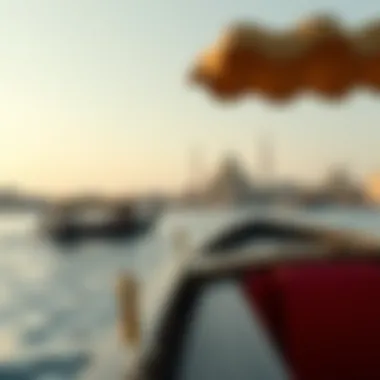
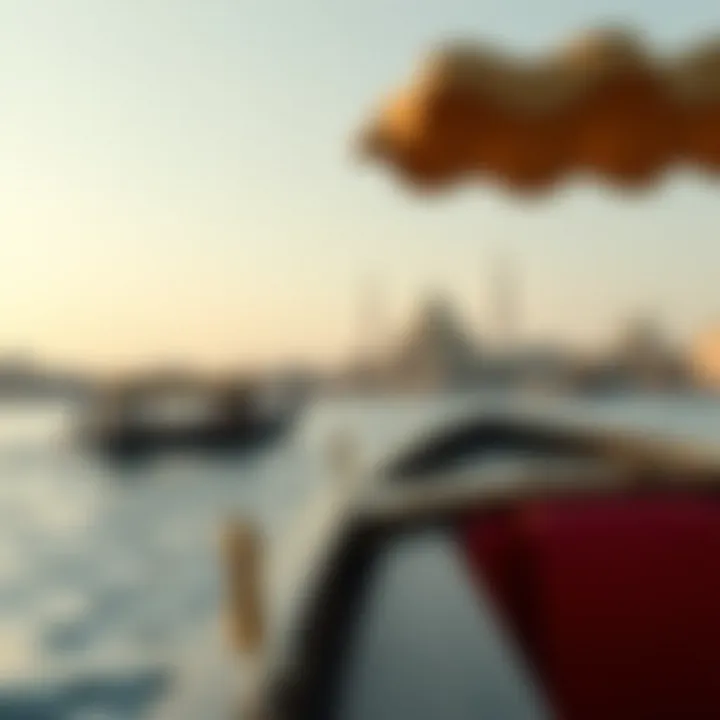
Challenges and Obstacles
The abra boat service in Dubai is a fascinating blend of history and modernity. However, it faces a few bumps in the road. Understanding these challenges is essential for stakeholders and users alike, as it gives clear insight into the operational dynamics of this service. From issues related to logistics to the social perceptions surrounding the abra, identifying potential obstacles helps in framing effective solutions.
Operational Challenges
When you dive into the mechanics of the abra service, you bump into several operational hurdles that hinder its smooth functioning. The reliability of the service is often in question due to factors like weather and engine malfunctions. Moreover, the fluctuating demand across different seasons creates a challenge in scheduling. During peak tourist seasons, for example, there’s a surge in demand which can lead to overcrowding or delays. Operators must juggle these fluctuations while ensuring safety and comfort for all passengers.
Additionally, many abras lack modern navigation and communication systems, posing a risk in busy waterways. Hence, the implementation of safety protocols becomes even more crucial. For investors and real estate analysts, recognizing these operational challenges will provide a more nuanced understanding of the service’s potential impact on property values and urban development.
Community Perception
Communities often hold the keys to evaluating any transport service's success. In the case of the abra, public perception ranges from nostalgic appreciation to concerns regarding safety and efficiency. Many locals view the abra as a lifeline, a connection to their cultural roots and a simple yet effective way to navigate the waterways.
However, some occupants voice concerns about the reliability and the skills of the operators. Issues such as overcrowding can lead to negative experiences, making some hesitant to use the service for daily commuting. Engaging the community through feedback mechanisms is vital to address these sentiments, ensuring that the service meets the needs of both residents and tourists alike.
It's worth noting that public perception can shape policy decisions, funding, and developmental initiatives. Stakeholders should take these perspectives into account, establishing a feedback loop that allows for continuous improvement.
"Community feedback can transform the service from just a means of transportation to a beloved aspect of Dubai's cultural identity."
Economic Impact
The abra boat service plays a multifaceted role in Dubai's economy. It serves as a vital artery within the urban transport ecosystem, connecting various neighborhoods and commercial zones while fostering social interaction among residents and tourists alike. Its influence on economic dynamics extends beyond just transportation; it touches upon aspects of tourism, real estate, and local business development. The integration of traditional and modern transport methods enhances the overall appeal of Dubai as a major metropolitan hub.
Contribution to Local Economy
The abra service is more than just a means of crossing the water; it’s a dynamic contributor to the local economy. When tourists embark on these traditional vessels, they're often looking to experience the authentic cultural ambiance of the city. This influx of visitors supports local shops, restaurants, and markets in proximity to the waterfront. It encourages expenditure in these sectors, ultimately enriching the ecosystem.
- The unique experience of traveling by abra can increase foot traffic in nearby areas, driving sales for small businesses.
- These boat rides often serve as a starting point for tourists who may choose to explore local attractions, thereby generating further economic activity.
- Furthermore, the maintenance and operation of the abra service itself involves local labor, which supports community employment.
Job Creation Potential
The existence of the abra service creates a myriad of job opportunities in Dubai. This can encompass a variety of roles, from the boat operators themselves to those working in supporting infrastructure and related services.
- Direct Employment: Operators and crew members of the abras are essential for the day-to-day functions. These positions provide steady jobs for many individuals, contributing directly to household incomes.
- Indirect Employment Opportunities: Support services such as boat maintenance, fuel supply, and marketing also emerge as necessary adjuncts to the abra service. This can involve boat builders, mechanics, and administrative staff.
- Tourism Sector Synergies: As tourism flourishes, jobs in hospitality and tour guiding increase as well. Tourists frequently look for guided programs that can include an abra ride, prompting opportunities for local guides to engage and expand their services.
The abra service stands as a testament to Dubai's innovative blend of tradition and modernity. Its economic impact extends beyond transportation, fostering a vibrant local economy and stimulating job creation across various sectors.
In summary, the economic influence of the abra service on Dubai goes well beyond its fundamental purpose as a transport method. It cultivates local business development and creates livelihood opportunities, thus driving the broader economy forward.
Community Engagement
Community engagement in the context of the abra boat service is crucial for various reasons. It is not just about transportation; it’s about the connection between the people who live and work in Dubai and the environment they share. When community members are actively involved and invested in the service, it results in a better experience for users and strengthens the bond among residents.
One key aspect of community engagement is the promotion of local initiatives. These initiatives can vary widely—from clean-up drives along the waterways to cultural events on board the abras. Such events not only heighten awareness around the abra service but also foster a sense of ownership among locals. Additionally, engaging the community can lead to improved operational efficiencies. When residents feel connected to the service, they are more likely to participate in providing feedback and insights that can drive enhancements.
"Community engagement transforms transportation from a utilitarian function into a meaningful experience."
Local Initiatives
Local initiatives surrounding the abra boat service have the power to breathe new life into the community and keep tradition alive. For example, organizing annual festivals or events that celebrate the history of abras can encourage participation from both locals and tourists. This creates a vibrant atmosphere where cultural heritage is honored, making the abra ride more than just a crossing but a journey through Dubai’s past.
Moreover, initiatives like these can generate economic benefits. Local artisans can use these platforms to showcase their crafts, eventually leading to increased foot traffic and, consequently, business for surrounding shops and cafes. For instance, a traditional crafts market near a popular abra station not only boosts local commerce but also makes the location a must-visit for tourists intrigued by the authentic Dubai experience.
Community-led clean-up efforts around the stations also highlight residents' pride in their surroundings. Such actions can lead to cleaner waterways, which directly benefit the abra service by ensuring that the boats can navigate safely and efficiently.
Feedback Mechanisms
Feedback mechanisms are indispensable for the abra service. They provide a channel through which the community can express its views, concerns, and suggestions. One of the prominent ways feedback is gathered is through surveys conducted by local authorities or transportation departments. Simple yet effective, these surveys are often distributed on board the abras or at the docks, ensuring that user experiences directly shape service improvements.
In addition to surveys, social media has become a significant tool for gathering insights. Platforms like Facebook and Instagram allow users to share their experiences instantaneously. This is not just limited to complaints; positive anecdotes can also circulate, helping to build a community narrative around the service. Public discussions or forums on Reddit could delve deep into operational topics, allowing users to share thoughts and ideas on how to enhance their experience.
These feedback mechanisms maintain transparency and accountability in service operations. When the concerns of the community are addressed, it fosters trust between the service operators and the users. This trust can transform the abra service into a vital part of individuals’ daily lives, linking them not only to each other but also to the essence of Dubai itself.
Integration with Tourism
The abra boat service is more than just a means of crossing Dubai's waterways; it's a portal bridging tourists to the essence of this vibrant city. As Dubai thrives on tourism, the abra service plays a pivotal role, weaving itself into the fabric of visitors' experiences. Travelers come to immerse in the rich tapestry of culture, history, and lifestyle that the city has to offer, and surprisingly, the abra is a key player in that narrative.
Tourist Influx and Patterns
Understanding the ebb and flow of tourist visitation sheds light on the abra service's significance. Each year, millions flock to Dubai, drawn by its eclectic attractions, from the towering Burj Khalifa to the bustling souks. Often, these tourists find themselves on the shores of Dubai Creek, where the rhythmic hustle of the abras beckons them.
Rather than just snapping a picture of the iconic skyline from the shore, many choose to hop on an abra, where they can enjoy a different vantage point of Dubai. The experience can transform a mere crossing into a memorable adventure. Recent trends indicate that the majority of tourists prefer purchasing round-trip tickets, allowing them to seamlessly traverse between the historic and modern aspects of the city.
"From ancient trading routes to modern marvels, the abra serves as a journey through time for any visitor."
This service sees a notable increase in usage during peak tourist seasons like the Dubai Shopping Festival or during holiday celebrations such as Eid. This fluctuation not only highlights the demand but also underscores the role of abras in enhancing tourists’ itineraries, providing swift and scenic transport options that complement their travel plans.
Promotional Strategies
Promotion of the abra service can further bolster its integration into tourists’ experiences. While word-of-mouth remains a gentle whisper of influence, more structured promotional strategies can amplify its presence.
- Social Media Campaigns: Harnessing platforms like Instagram and Facebook can elevate the attraction of the abra experience. Stunning visuals of abras against pinkish sunlit skies can entice potential tourists, painting a vivid picture of Dubai's charm. Local influencers often create engaging content that highlights the unique feel of riding an abra.
- Collaborations with Hotels: By partnering with local hotels, the abra service can be positioned as a complimentary travel option for guests. Hotels can offer packaged deals that include abra rides, enhancing the appeal of their accommodation options.
- Cultural Festivals: Participating in cultural events or organizing abra-themed celebrations can attract footfall. Adding live traditional music or local art displays on abras during key events can create a captivating atmosphere that appeals to tourists seeking authentic cultural experiences.
These strategies could refine the tourist experience, bolstering foot traffic for the abra service and simultaneously enriching the overall visitor experience in Dubai. As this ancient mode of transport continues to glide over the waters, it embodies both connection and discovery, making it an unforgettable part of the tourist landscape.
The End
The conclusion serves as a vital reflection on the importance of the abra boat service within Dubai's urban tapestry. Not only does this transport method connect various neighborhoods, but it also underscores the city's rich maritime heritage. The abra's existence is a reminder of simpler times, providing a unique mode of transit that complements modern advancements.
Summarizing Key Insights
As we look back through the article, several key takeaways stand out regarding the abra service:
- Cultural Continuity: Abras are deeply embedded in Dubai’s cultural identity. They symbolize a bridge between past and present, showing how traditional practices can coexist with rapid modernization.
- Essential Transportation: With a straightforward fare structure and ubiquitous routes, abras offer an affordable and accessible means of transport. Such features make them pivotal for both residents and tourists alike.
- Economic Catalyst: The abra service not only aids in the local economy but also enhances real estate appeal. Proximity to an abra station can significantly influence property value, making it attractive for investors.
- Environmental and Sustainability Aspects: Also notable is the shift towards sustainable practices within the abra service. As awareness of environmental issues grows, there’s a movement toward greener operations that could enhance the service's longevity.
- Community Feedback: The connection between the abra operators and the community is critical. Listening to suggestions and concerns can lead to improvements that benefit everyone involved.
"The abra boat service is more than just a way to cross the creek; it is part of the soul of Dubai, linking people and places across time and space."







